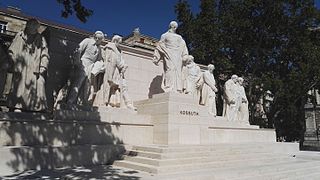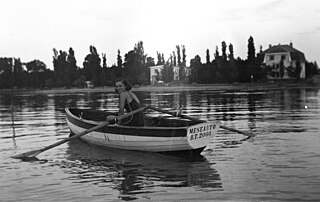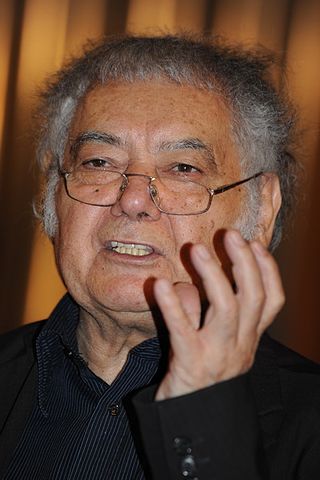
Kossuth County is a county in the U.S. state of Iowa. As of the 2020 census, the population was 14,828. The county seat is Algona.

Lajos Kossuth de Udvard et Kossuthfalva was a Hungarian nobleman, lawyer, journalist, politician, statesman and governor-president of the Kingdom of Hungary during the revolution of 1848–1849.

Cegléd is a city in Pest county, Hungary, approximately 70 km (43 mi) southeast of the Hungarian capital, Budapest.

Kossuth Lajos Square, also known as Kossuth Square, is a city square situated in the Lipótváros neighbourhood of Budapest, Hungary, on the bank of the Danube. Its most notable landmark is the Hungarian Parliament Building. There is a station of the M2 (East-West) line of the Budapest Metro on the square as well as a stop for the scenic Tram No. 2.

Hősök tere is one of the major squares in Budapest, Hungary, noted for its iconic Millennium Monument with statues featuring the Seven chieftains of the Magyars and other important Hungarian national leaders, as well as the Memorial Stone of Heroes, often erroneously referred as the Tomb of the Unknown Soldier. The square lies at the outbound end of Andrássy Avenue next to City Park (Városliget). It hosts the Museum of Fine Arts and the Palace of Art (Műcsarnok). The square has played an important part in contemporary Hungarian history and has been a host to many political events, such as the reburial of Imre Nagy in 1989. Most sculptures were made by sculptor György Zala from Lendava, with one made by György Vastagh.

The Hungarian Parliament Building, also known as the Parliament of Budapest after its location, is the seat of the National Assembly of Hungary, a notable landmark of Hungary, and a popular tourist destination in Budapest. It is situated on Kossuth Square in the Pest side of the city, on the eastern bank of the Danube. It was designed by Hungarian architect Imre Steindl in neo-Gothic style and opened in 1902. It has been the largest building in Hungary since its completion.

Kossuth Memorial refers to one of three public monuments dedicated to former Hungarian Regent-President Lajos Kossuth in front of the Hungarian Parliament Building on Lajos Kossuth Square in Budapest. The memorial is an important Hungarian national symbol and scene of official celebrations.

The 2006 protests in Hungary were a series of anti-government protests triggered by the release of Hungarian Prime Minister Ferenc Gyurcsány's private speech in which he confessed that his Hungarian Socialist Party had lied to win the 2006 election, and had done nothing worth mentioning in the previous four years of governing. Most of the events took place in Budapest and other major cities between 17 September and 23 October. It was the first sustained protest in Hungary since 1989.
Bloody Thursday, Thursday Massacre or Thursday Night Massacre may refer to:

The Thirteen Martyrs of Arad were the thirteen Hungarian rebel generals who were executed by the Austrian Empire on 6 October 1849 in the city of Arad, then part of the Kingdom of Hungary, after the Hungarian Revolution (1848–1849). The execution was ordered by the Austrian general Julius Jacob von Haynau.

The Shoes on the Danube Bank is a memorial erected on 16 April 2005, in Budapest, Hungary. Conceived by film director Can Togay, he created it on the east bank of the Danube River with sculptor Gyula Pauer to honour the Jews who were massacred by fascist Hungarian militia belonging to the Arrow Cross Party in Budapest during the Second World War. They were ordered to take off their shoes, and were shot at the edge of the water so that their bodies fell into the river and were carried away. The memorial represents their shoes left behind on the bank.

The Hungarian Revolution of 1848, also known in Hungary as Hungarian Revolution and War of Independence of 1848–1849 was one of many European Revolutions of 1848 and was closely linked to other revolutions of 1848 in the Habsburg areas. Although the revolution failed, it is one of the most significant events in Hungary's modern history, forming the cornerstone of modern Hungarian national identity - the anniversary of the Revolution's outbreak, 15 March, is one of Hungary's three national holidays.

Balatonszabadi is a village in Somogy county, Hungary.

The Academy of Drama and Film in Budapest is an educational institution founded in 1865 in Budapest, Hungary. It became a university in 2000 and the name was changed to University of Theatre and Film Arts.

The Kossuth Prize is a state-sponsored award in Hungary, named after the Hungarian politician and revolutionist Lajos Kossuth. The Prize was established in 1936, by the Hungarian National Assembly, to acknowledge outstanding personal and group achievements in the fields of science, culture and the arts, as well as in the building of socialism in general.

Sándor Csoóri was a Hungarian poet, essayist, writer, and politician.

Stanisławów Ghetto was a ghetto established in 1941 by Nazi Germany in Stanisławów in German occupied Poland. After the German invasion of the Soviet Union, the town was incorporated into District of Galicia, as the fifth district of the General Government.

On Sunday, 11 July 1943, OUN-UPA death squads, aided by local Ukrainian peasants, simultaneously attacked at least 99 Polish settlements within Wołyń Province of the German-occupied prewar Second Polish Republic. It was a well-orchestrated attack on people gathered at Catholic churches for Sunday mass. The towns affected included Kisielin, Poryck, Chrynów, Zabłoćce, and Krymn, while dozens of other towns were attacked on other dates; tens of churches and chapels were burned to the ground.
The following lists events that happened during 2018 in Hungary.
















